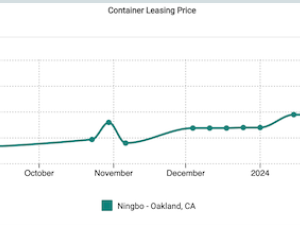Korea’s Hanjin Shipping Becomes Symbol of Industry in Pain
By: Kyunghee Park and Christian Wienberg | Aug 31 2016 at 04:54 AM | Liner Shipping
Hanjin Shipping Co., the distressed Korean container mover that filed for court protection Wednesday, is emerging as a symbol of the slump that has plagued the industry since the global financial crisis.
South Korea’s largest container-shipping company applied for court receivership after lenders rejected a restructuring proposal saying it was insufficient to tide over a cash shortage. The firm may still need as much as 1.3 trillion won ($1.2 billion) in cash to roll over debt in the wake of losses in four of the last five years, main creditor Korea Development Bank said Tuesday.
Hanjin’s woes show the container-shipping industry is still in bad health, limping from one exigency to another since the 2008 crisis brought trading to its knees. Helped by cheap loans, container lines have hung on even as freight rates to move sneakers to Barbie dolls from Asia to Europe and the U.S. plunged. From A.P. Moeller-Maersk A/S to Hapag-Lloyd AG and France’s CMA CGM SA, companies have tried everything—mergers, acquisitions and cost cuts—while a revival in demand remains elusive.
Heavy Losses
“We have been seeing some reorganization in the container industry and hopefully it can lead to fewer container lines with healthier balance sheets,” said Espen L. Fjermestad, an analyst at Fearnley Securities AS in Oslo. “It could be healthy for the industry as a lot of companies have been stimulated with outside money for a long time to still exist despite heavy losses.”
Hanjin Shipping’s 5.9 percent June 2017 local-currency notes fell to a record-low 27.3 percent of face value on Aug. 30, Korea Exchange prices show. In Singapore, Neptune Orient Lines Ltd.’s September 2020 dollar bonds traded at 71.65 cents on the dollar.
Its shares plunged 24 percent to 1,240 won on Tuesday in Seoul, the lowest closing price since December 2009, before trading was halted. They have tumbled 66 percent this year, compared with a 3.7 percent gain in the benchmark Kospi index. Hyundai Merchant Marine Co. shares have fallen 68 percent this year.
Headed for another year of losses, Hanjin Shipping has been trying to reschedule debt under a voluntary program led by creditors since May. Hyundai Merchant has been taken over by creditors after meeting conditions, including adjustments in charter rates on vessels it leased from shipowners.
More Liquidity
Hanjin Shipping said Monday that it could generate about 1.27 trillion won in additional liquidity, partly by extending maturities of some debt and charter rate adjustments. Its biggest shareholder, Korean Air Lines Co., also planned to provide 400 billion won.
“Creditors found it difficult to accept Hanjin Shipping’s plan,” Korea Development Bank said. “It’s uncertain whether the company could turn around.”
The Hanjin group, whose business units include airline and mineral water, said it will put in all efforts to revive its shipping unit. The shipping line is the world’s seventh-biggest by capacity with a 2.9 percent market share, according to maritime consultant Alphaliner. The Korean company owns 59 of 132 container and bulk ships in its fleet.
Mergers, Job Cuts
“The Hanjin group doesn’t want to support the shipping arm any further at the risk of their other businesses, and most creditors have also came to the same conclusion,” said Kim Jinha, head of global fixed income at Mirae Asset Global Investments Co. in Seoul. “From what we can see, the government wants this to be a model for future restructuring of troubled industries. For that, the state and domestic support chains need to be well set up.”
Hanjin Shipping had the equivalent of $5.3 billion of total liabilities on June 30, according to its latest quarterly filing. That already surpassed the $4.5 billion liabilities reported by Pan Ocean Co. when it filed for Chapter 15 creditor protection June 2013 in the U.S., the most in South Korea’s transportation industry, according to Bloomberg-compiled data.
The global shipping industry has been operating at a loss since the end of 2015, and it’s set to lose about $5 billion this year amid an oversupply of vessels, according Drewry Maritime Research.
CMA CGM bought Neptune Orient for S$3.38 billion ($2.5 billion) this year in the industry’s biggest acquisition since 2005. Hapag-Lloyd and United Arab Shipping Co. said in June they agreed to merge. China last year merged China Ocean Shipping Group and China Shipping Group to form China Cosco Shipping Corp.
Shipping isn’t the only industry that’s struggling. Shipbuilding and the oil and gas sectors are also in the midst of restructuring after a slump in oil prices over the last two years caused energy projects to be delayed and shrank shipping demand.
The weekly China Containerized Freight Index, which tracks cargo rates on major shipping lanes, fell to the lowest level in April this year since the data was first set in November 2010, according to the the Shanghai Shipping Exchange.
“The M&As and restructuring we’re seeing right now is more about survival,” said Rahul Kapoor, a Singapore-based director at Drewry Maritime Services Pvt. “They don’t lead to pricing power coming back. The number of ships is still the same. Pricing power comes with demand.”





